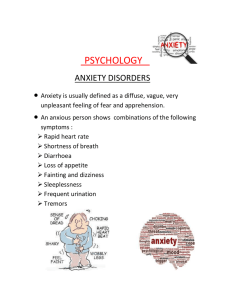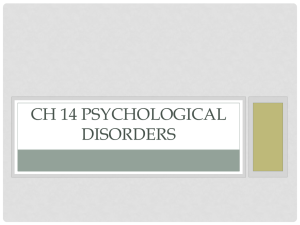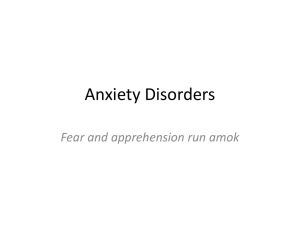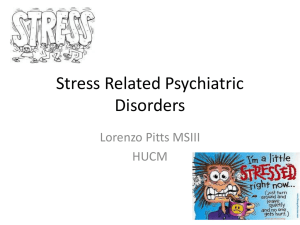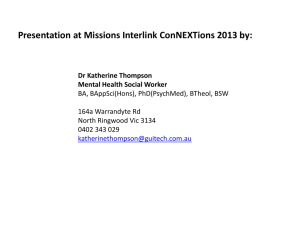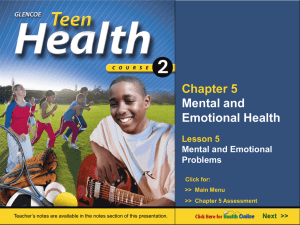Neurotic disorders - the Peninsula MRCPsych Course
advertisement
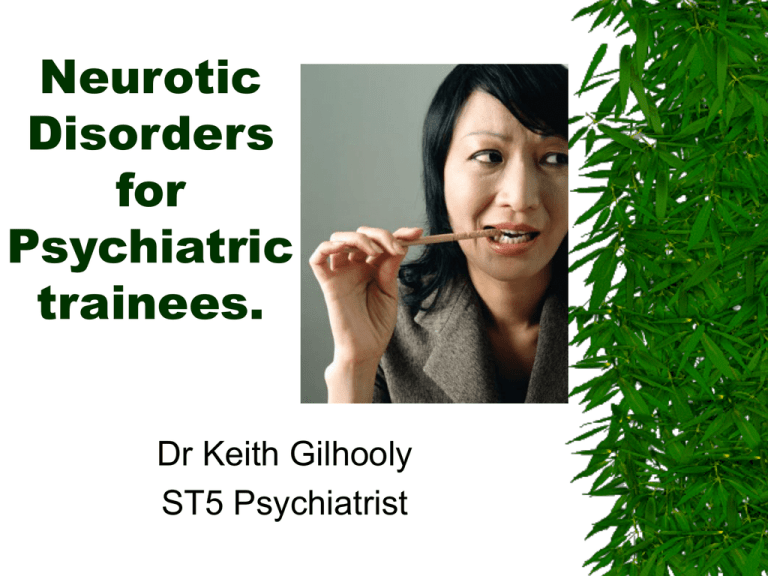
Neurotic Disorders for Psychiatric trainees. Dr Keith Gilhooly ST5 Psychiatrist General points. Lots of comorbidity in these disorders especially with depression, other neuroses, PD, and substance misuse For useful prevelance data….. ECA. Euroupean catchment area survey. (Robins & Regier, 1991) NCS. National Co morbidity study . US http://www.hcp.med.harvard.edu/ncs/ See back of handout. Licences.( Arbitary). If asked pharmacological treatment for anxiety disorder if in doubt say “SSRI Eg. PAROXETINE.” It is licensed for – Social anxiety, GAD, Panic disorder, OCD, PTSD Sertraline OCD, PTSD Fluoxetine OCD Esitalopram GAD, OCD, Panic disorder Don’t forget emphasise patient choice Psychodynamic understanding of anxiety disorders. Focus on; 1.Intrapsychic conflicts. 2.Unconcious fantasies. 3. Defense mechanisms 4. Compromise function of symptoms. Freud Freud 1926 identifies 2 types anxiety. Signal and traumatic. Signal anxiety alerts ego to Id impulses,and fantasies inconsistent with super ego. If defenses put in place by super ego ineffective get traumatic anxiety. (GAD, Panic disorder) Compromise formations If defense mechanism immature ego synthesises compromise between the wish and the defense. Psychiatric symptoms as well as dreams and further fantasies are compromise formations. Pleasure principle. Symptoms less distressing than underlying conflict. Neurosis as opposed to perversion Perversion- regress to earlier stage psychosexual development and hypertrophy of that drive. If this hypertrophied drive sufficiently repressed then the individual developed a neurosis. Phobias- theories Pavlovian (Classical/ associative) conditioning. An association is formed between the stimulus and feeling threatened. Watson shock /furry rabbit(1919) Operant conditioning.Two factor theory. Mowrer. Avoidance behavior that strengthens the “negative reinforcer” Phobias. Theories. Psychodynamic- displacement of anxiety from an unacceptable object eg self destructive impulses (Freud, Little Hans), onto a more acceptable object. Displacement projection and avoidance. Learning theory- vicarious and direct learning from others that a situation is threatening. Innate or prepared behaviours. Phobias F 40 ICD 10 Diagnostic Common factors and differences Phobias Seen in up to 15% of people Characterised by– Subsection A. Certain Specific thing or situations, not CURRENTLY dangerous. Fear and or Avoidance of phobic stimulus external to subject. Subsection B (12 symptoms) 4 Autonomic arousal – Palpitations, sweating, shaking, dry mouth. 4 Chest and abdo symptoms. Diff breathing, choking, chest pain, nausea. 4 Mental state symptoms. Dizzy,derealisation, depersonalisation, fear losing control, fear dying. Phobias. Subsection B cotd. Need 2 of these for agorophobia and social phobia. For specific phobias number not specified. Sebsection B for social phobia additionally has, blushing, shaking, fear of vomiting, and urgency/ fear of micturition Subsection B also used in Dx GAD. Need 4 of them. Subsection B also used in panic disorder and suggested that all subsection B symptoms characteristic. Section C and D. – C Significant emotional distress. Insight “Excessive and unreasonable” – Symptoms in situation or in anticipation of it. – Panic disorder can be secondary diagnosis to phobia and can indicate severity. Agorophobia F40.0 With above criteria(SectionA) specific fear or avoidance must be of at least 2 of the following. Crowds public spaces travelling alone travel away from home. Agorophobia Stats Lifetime prevelence 2-6% across studies. 6 month prevelence 2.5-5.8% ECA M:F 1:3 Bimodal. Two peaks. 1. early-mid 20’s. 2.Mid thirties. Therefore later than other phobias. Agorophobia treatment SSRI first choice. Start low but can aim high. Eg paroxetine at least 40mg, can go to 60 mg.(same as panic disorder) Clomipramine/Imipramine second line (unlicensed) MAOI or augment with Lithium. Mood stabiliser Social Phobias F40.1 Fear or avoidance specifically of – Focus of attention. – Potentially embarrassing or social situations May be specific eg eating, vomiting, pub speaking. Stats Lifetime prevalence 2.4-13.3% 12 month prevelence 7.9% M=F presenting for help. Comm survey M>F. Peak 5 yrs and 11-15 yrs. MZ/DZ 24.4%:15.3%???genetic predisposition to interpret things as dangerous. Social phobia. Teatment As usual CBT. Could be group setting. Social skills training. Modelling and graded exposure. SSRI/ . Evidence for paroxetine, fluvoxamine and sertraline and MAOI. Social phobia. Treatment Paroxetine and escitalopram licensed. Response rates up to 90% with combined approaches. B-blockers. Only evidence that they help with short term control of tremor and palpitations Simple Phobias Phobia associated with single stimulus eg spiders, flying etc Lifetime prevelence 11.3% Onset usually childhood with M=F As adults is F>M (3:1-20:1) Mean onset 15 years. Animal phobias 7 years Childhood- usually environmental eg animals Adult- usually situational eg places Treatment.CBT Systemic desensitisation. Graded exposure Reciprocal inhibition. Relaxation (Wolpe) Modelling Avoidance is safety behaviour that results in negative re enforcement. Cognitive distortions related to negative re enforcement. “If I am anxious it must be dangerous” Treatments CBT Modelling Implosion Flooding no better than graded exposure. Psychodynamic. ??? What conflict symptoms represent. Repressed impulses brought to counciousness. Little Hans (Freud) Medications-generally not used Some unusual Phobias Pogonophobia -Beards Bogyphobia -Bogeyman Panophobia -Everything Syngenesophobia -Relatives ??Hippopotomonstrosesquippedali ophobia. -Long words Phobic Disorders.. Phobia % of phobias F:M Age of onset Agora 60% 2-3:1 15-35 Social 8% Simple 17% 1:1 13-20 presenting for help 3-20:1 Childhood Illness 15% F=M ? OCD - F=M 20 Panic Disorder 4 non-situational panic attacks over 4/52 May be ‘non-fear’ in 10% ie don’t describe feeling fearful. Descrete, abrupt, reaches max after a few minutes. Same list autonomic, chest, and mental state symptoms. Panic Disorder Stats. Lifetime prevelence 4.2% (ECA, NCS) M:F 1:2-3 Peaks 15-24, 45-54. Co morbidity with agorophobia 75% Psyche clinic. In ICD 10 primary diagnosis would be agorophobie. In DSM, other way round Panic Disorder Probably imbalance of NA:5HT in caudate nucleus May be linked to childhood respiratory disorders (suffocation alarm) Highly comorbid (depression (50%), ETOH (40%), OCD, phobias, somatisation) Panic Disorder treatment. NICE Guidelines 2004.Patient choice.Restricted Meds and or CBT SSRI first choice. Clomipramine/Imipramine second line (unlicensed,70-80% effective) Start low but can aim high. Eg paroxetine can go to 60 mg. CBT. Teach about body responses? Thinking errors about dying. Relaxation techniques Control hyperventilation Generalised Anxiety Disorder F41.1 A. Non situational anxiety on most days for 6 months. Need 4 symptoms from subsection B. One of these must be from autonomic arousal section. Subsection B for GAD has added general and non specific symptoms also. Lifetime prevelence (NCS)3-4% F:M 2:1 Mean onset 21.(Range 2-60 yrs) 50% also depressed Only 1/3 seek help Genetic heritability 30% Neurobiology Loss regulatory control HPA axis. Dex sup test reduced cortisol supression. Decrease GABA Dysregulation 5-HT system. Sustained activation stria terminalis after prolonged CRF. Increase startle response. Cognitive model (Dugas 2004) Belief that worry keeps you safe (Prepared) Cannot tolerate uncertainty. Search for perfect solutions leads to failure and further worry. ?? Worry inhibits emotional processing that is more distressing GAD adults report “”reverse parenting” Unpredictability of outcomes Cold, over controling parents. Sensitised to needs of others. (To stay safe in childhood) Child learns to inhibit own emotional experience and rely on anticipatory problem solving Rank high on empathy and worry about interpersonal issues Treatment. NICE patient choice. Some evidence that CBT works. SSRI. Paroxetine licenced.Same titration as for depression (BNF) Venlafaxine 75 mg od. Discontinue if no response after 12 weeks. Imipramine and clomipramine Obsessive Compulsive Disorder Recurrent, intrusive, unpleasant thought, feelings, images or impulses (obsessions) +/- compulsive behaviours (aim at reducing anxiety) Must be senseless to patient, resisted, internal, and under own control ie not imposed from external source. Most common obsessions are contamination and doubts Most common compulsions are checking and cleaning OCD Affects 2-3% Onset in 20s F=M Often comorbid with 2/3 depressed and ¼ socially phobic Often delay 5-10 years before seeking help Shopping, gambling, eating not OCD as behaviour is ego-syntonic ie pleasant OCD Worse outcome if early onset, bizarre obsessions, overvalued ideas and always yield to the compulsion Treat with CBT- exposure to stimulus with response prevention, loop tapes. Medication- SSRIs, clomipramine Best is combination- meds + CBT. Psychosurgery in extreme cases Psychodynamic Theory Similar to phobias. Id impulses and fantasies in conflict with excessive super ego. Defense of magical undoing in compulsions to make reparation for phantasised destructiveness. Intellectualisation leads to pre occupation and and thus avoidance of conflict. Therapy. Deal with issues of control. Loosen excessive super-ego. CBT (Salkovskis). Intrusive thoughts normal. Those with OCD have increased sense of responsibility and self blaming belief systems (Core assumptions) that trigger secondary NAT’s. CA may be “Only immoral people have such thoughts” Exaggerated sense of responsibility. Rather than dismiss thought end up ritualising to undo. Thought =Action Failing to prevent harm= causing harm. No attenuation of concern by low probability Adjustment Disorders Maladaptive response to a stressor that interferes with functioning Includes bereavement and adjustment to medical disorders eg occurs in 5% after medical admission F:M 2:1, any age Acute Stress Reaction Occurs following exceptional stress Lasts hours to days May involve anger, depression and withdrawal. Resolves on removing the stressor Post Traumatic Stress Disorder Affects 1-5% (more subclinical) Event is perceived as life threatening often with helplessness Involves– Reliving the event – Avoiding things associated with the event – Increased arousal eg anxiety – Numbing of response eg anhedonia PTSD Aetiology- ‘Cognitive processing model’lack of processing due to being overwhelmed by the emotional value of the event (level of processing theory) Treat with CBT and meds (SSRIs). Also eye movement desensitisation and reprogramming (EMDR therapy), hypnotherapy and analytical psychotherapy. Somatoform Disorders Characterised by physical symptoms persisting despite negative findings Somatisation disorder (Briquets syndrome)multiple, variable sx in different systems for >2 years. Uncommon (0,10,2%) with F:M 20:1. Onset in teens to 20s High comorbidity Somatoform Disorders Hypochondriacal disorder- focus is that mild symptoms indicate serious disease Includes body dysmorphic disorder Affects 5% with F=M, onset 20-30s 80% also depressed/anxious. Dissociative/ Conversion Disorders Loss of integration of memories, control of body and identity with a psychological cause (previously called hysterical reaction) Allow a patient to avoid direct expression of distress- ie distress is expressed as physical symptom Up to 20% have histrionic PD Dissociative Disorders Dissociative disorders of movement and sensation of psychological cause- usually accompanied by ‘belle indifference’ (a seeming to not care about the symptoms). Dissociative amnesia- patchy loss of memory for unpleasant events Dissociative fugue- amnesia with a purposeful journey away from home with maintained self care Dissociative Disorders Underlying physical cause found in 1-2/3 (be cautious not to miss!) F:M 2-5:1 often with Fhx. Onset as young adult Rural>urban (odd) and low SE class 90% resolve in 1/12 Depersonalisation/ derealisation A subjective ‘as if’ phenomena that things are remote, unreal and automatised with intact insight Often fleeting and may be normal May decrease anxiety but is unpleasant Usually part of another disorder eg anxiety or depression F:M 2:1

